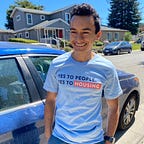Creating homes for the holidays
Oh the weather outside is frightful, but sometimes there is no fire to be delightful.
Have you ever read the lyrics to “Let it Snow”? How different would it be if you were unhoused or your housing situation was precarious? I think about it every holiday season.
It’s that time of year again and things are sort of back to normal. While COVID-19 is still surging, this holiday season has shown to be a bit better than the last. With precaution and responsibility, the availability of vaccinations, boosters and accessible testing has let many Bay Area residents return to some holiday comforts sorely missed. Family, food and being home for the holidays. But the impacts of the pandemic and the socioeconomic realities that existed before still makes it difficult or impossible to celebrate for so many Bay Area residents.
In 2020, more than 50,000 people in the Bay Area sought assistance for critical services related to experiencing homelessness. Homelessness is an experience not an identity. But the realities of how we treat this experience unfortunately differ. Basic human functions needed for survival, such as sleep, eating and using the restroom, are criminalized in public settings. It also takes shape in many forms that are often unseen, such as residing in a navigation center, couch surfing or sheltering in one’s car. While the scale of those experiencing homelessness is widely covered, the actual experience and how one reaches this point is often misconstrued.
A recent report from UC Berkeley’s Terner Center, in partnership with All Home, highlights how nearly “17% of households — more than 1 million people — in the Bay Area were extremely low income, meaning that their income was less than 30% of the median in the county in which they lived,” with over 2 million additional people between very low and low income (30% to 50% Area Median Income and 50% to 80% Area Median Income, respectively). Nearly 70% of those extremely low households in San Mateo County are severely rent burdened.
The report also finds that a lack of social safety nets, inadequate housing supply (both affordable and market-rate), and an overall lack of living wage jobs contribute to structural barriers for those at-risk to achieve housing stability. The impacts of COVID-19 have only amplified these existing barriers. Above all, behind these stats, facts and figures are actual names, faces, families and stories grappling with the daily realities of experiencing housing insecurity or homelessness. Humans grappling with the indignities of upcoming freezing weather. No warm fire, no escape from the elements.
When it comes to housing, there is no magic answer. Decades of intentional policy choices and disinvestment in people got us here, but progress is being made to undo them.
Last year, the San Mateo County Board of Supervisors approved several Project Homekey proposals to act as new permanent and transitional housing. This year, we were one of the first to receive Homekey funds. Shelter, while desperately needed, is only part of the goal on the road to housing stability. State streamlining of affordable housing financing, while “wonky,” can play a huge impact in funding affordable homes. And while the prospects of the federal “Build Back Better” bill are not looking great, the contents of the bill remain one of the best opportunities to make significant federal investments in affordable housing across the country.
But what can we do at the local level?
Never underestimate your power to send an email or make public comments at your city council or board of supervisors. Local support, your support, plays a huge role in encouraging the creation of new homes, such as directly supporting a housing proposal in your community. But wait! There’s more.
By encouraging things like reducing parking minimums (that eat up potential homes), land trusts, easing ADUs creation, supporting “plexes” and asking for the prioritization of public lands for deed-restricted affordable home creation, you can make a significant impact on how your local community becomes more inclusive.
These approaches are not exhaustive and there are additional opportunities at all levels of governments to help our most vulnerable community members, from expanding housing choice vouchers, strengthening renter protections, improving outcomes in the labor market and more.
Make no mistake, there are a bevy of structural harms not mentioned and addressing them requires some combination of land, money and political will. But investments into housing lays the groundwork for economic opportunities, health and educational outcomes. Investments that manifest in people. The cost of inaction, too high. Don’t believe me? Take a brief step outside.
When it comes down to it, it’s about four walls and a door, a roof over heads and a feeling of having a home for the holidays.
Alex Melendrez is a former affordable housing organizer, a current board member of the Peninsula Young Democrats and lead with housing and transportation equity group Peninsula For Everyone.
OP-ED originally written in San Mateo Daily Journal: https://www.smdailyjournal.com/opinion/guest_perspectives/creating-homes-for-the-holidays/article_4f270cd8-6394-11ec-b130-73f1478c9526.html#comments
